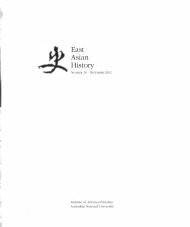Mujaku Dochu (1653-1744) and 17th-Century ... - East Asian History
Mujaku Dochu (1653-1744) and 17th-Century ... - East Asian History
Mujaku Dochu (1653-1744) and 17th-Century ... - East Asian History
Create successful ePaper yourself
Turn your PDF publications into a flip-book with our unique Google optimized e-Paper software.
Figure 9<br />
Japanese commentary on the Fa-men<br />
ch'u-kuei published in 1846<br />
enlightenment (or Buddha-nature), how<br />
could the original meaning of scriptures<br />
be found?-through the use of reason<br />
<strong>and</strong> logic or through direct intuition.<br />
Chen-ch'eng's work, <strong>and</strong> that of Chuhung,<br />
in fact made great advances in<br />
Ch'an studies, using scriptural evidence<br />
<strong>and</strong> logic to verify enlightenment, <strong>and</strong> in<br />
unifying methodology <strong>and</strong> practice. 1 28<br />
Thus, it is not surprising that this debate<br />
should have attracted <strong>Mujaku</strong>.<br />
The Theses of Seng-chao (Chao-lun<br />
gifH), of which the Thesis that Things<br />
Do Not Shift is a part, was probably<br />
brought to Japan soon after Buddhism<br />
arrived there. A commentary by Hui-ta<br />
Ji was copied in 726 <strong>and</strong> one of the<br />
commentaries was reprinted several<br />
times in the Tokugawa period. The<br />
Debates over the Interpretation of the<br />
Thesis that Things Do Not Shift (Wu<br />
pu-ch'ien lun pien-chieh /f§ifHm<br />
iW) by Chen-chieh W was printed in<br />
MUJAKU DOCHU<br />
Japan in 1655. Yet Makita Tairy6 E!3gw concludes that the Theses<br />
of Seng-chao was not as widely read in Japan as it was in China as<br />
its ideas were too remote <strong>and</strong> elevated. 1 29 Yet <strong>Mujaku</strong> seems to have<br />
given some importance to the Theses of Seng-chao. He used it to<br />
attack the scholarship of Ryukei Sh6sen (1602-70) who with Somon<br />
<strong>and</strong> had worked to introduce Yin-yUan Lung-ch'i to Kyoto <strong>and</strong> Edo.<br />
Ryukei later defected to Obaku, which <strong>Mujaku</strong> saw as a betrayal.130<br />
<strong>Mujaku</strong> not only mentioned the famous commentary to the Thesis by<br />
Wen-ts'ai Jet (1241-1302), but also referred to the late-Ming work<br />
of Chen-ch'eng several times on the issue of whether the Buddhanature<br />
is eternal. 1 31 However, in the Worn Besom of the Platform<br />
49<br />
128 Chiang, Chung-kuD, pp.253-59.<br />
129 Makita, "Joron no ryuden ni tsuite," p.290,<br />
298. Chen-chieh rewrote his text in 1597, so<br />
his initial version predates this, see Chiang,<br />
Debates <strong>and</strong> Developments, p.243. Chenchieh's<br />
text is in HTC vo1.97.<br />
130 Jorgensen, "Zen Scholarship," pp.2, 9-10,<br />
for details.<br />
1 3 1 Wan'un reiu, MSS, 238b.

















